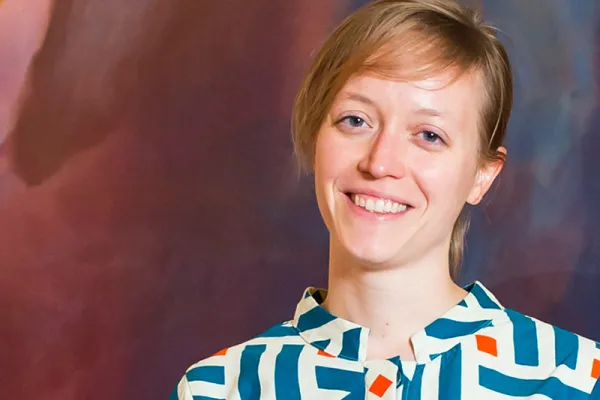The Power of Contemporary Art
Smith Arts

Published January 10, 2018
Smith’s first contemporary art curator, Emma Chubb didn’t grow up around contemporary art.
But when she was in 10th grade, she was “lucky enough to have an English teacher who decided to teach us about modern and contemporary art,” she says, “even though it wasn’t in the Pennsylvania state curriculum.” On a class field trip to the 1999 Carnegie International, she saw works by artists like William Kentridge, Shirin Neshat and Kara Walker.
“Seeing this art was a way into a world that I didn’t know,” Chubb says. “It allowed me to travel across space and time—to see ways of picturing and ways of making that made me want to learn more.”
Now, as the college’s first Charlotte Feng Ford ’83 Curator of Contemporary Art, Chubb hopes to provide that mind-opening experience for Smith students and members of the broader community. “I want to help the Smith College Museum of Art be a place where people can encounter what is unexpected and difficult,” she says.
With expertise in North African and Middle Eastern video art, photography and site-specific sculpture—as well as broader interests in migration, minority communities and cross-cultural exchange in contemporary art and visual culture—Chubb recently collaborated with senior curator Aprile Gallant on Un/American, an installation of works that raise questions about Americanness and censorship.
She’s also getting to know the museum’s contemporary collection, and meeting as many people as possible—especially students. “I want people to know that the museum is a place that’s open and available,” she says. “I’m excited to work with you!”
Here’s what Chubb had to say about her new role at Smith, the unsettling power of museums, and why contemporary art matters.
Why did you want to become a museum curator?
I knew I wanted to make a contribution to the field, and to change what and whose art is privileged in the United States. I thought I could shift the conversation by being involved with museums—by helping to build collections and exhibiting art that had previously not been in the foreground. I love research, I love working with students, and I love working with artists—and as a curator of contemporary art at Smith, I get to do all three, all the time.
Smith is one of the few college or university museums with a contemporary art curator. Why does that matter?
Contemporary art offers a meaningful way to travel through the world. It challenges preconceived ideas and exposes blind spots; it teaches us to see and think anew. But even though so much contemporary art is about moving away from elitism and out into the world, it’s often the least accessible, even if you’ve studied art history. My hope is that bringing more contemporary art and artists to campus will provide opportunities for the Smith community to connect to the world and to one another.
What are the particular opportunities that Smith provides?
Smith’s museum is wild as a resource—for a college of any size—and it’s so exciting to dig into the rich collection and the stories it contains. In addition, because Smith is a women’s college, women appear in our galleries and in our offices as more than the painted and the underpaid. People at other institutions have asked me if we have dedicated funds to buy works by women. I tell them, “No. The reason we buy works by women isn’t that we’re a women’s college. We collect works by women because these artists are fundamental to the history of art. Period.”
How do curators shape the conversation?
Museums are not neutral. They never have been. Everything we do is position-taking. What we decide to program—that takes a position. Shows that include 50 percent or more art by women—that takes a position. Exhibiting works that center on African American experiences—that takes a position.
Why is contemporary art important?
Art dwells in the middle of this messy soup of things called life, and art can transform how people think and move in the world. Art provides a way into difficult topics while allowing for, even embracing, disagreement. There are as many ways to experience a work of art as there are people to see it. And it’s important not to be didactic about it. Most of what art does is communicate contradictory things; art asks questions about representation, and representation is all about identity, history and power. I’m committed to bringing these conversations forward.